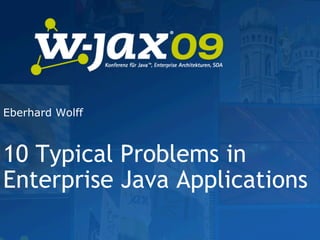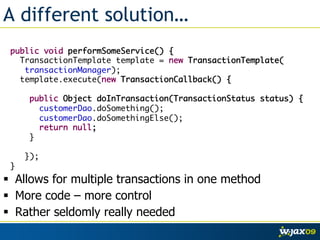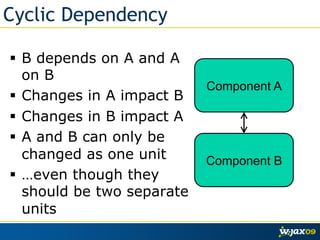10 Typical Problems in Enterprise Java Applications
- 1. Eberhard Wolff 10 Typical Problems in Enterprise Java Applications
- 2. Why this talk? I do a lot of reviews There are some common problems you see over and over again So: Here are 10 • …not necessarily the most common • ...but certainly with severe effects
- 3. #1 public class Service { private CustomerDao customerDao; private PlatformTransactionManager transactionManager; public void performSomeService() { TransactionStatus transactionStatus = transactionManager .getTransaction(new DefaultTransactionDefinition()); customerDao.doSomething(); customerDao.doSomethingElse(); transactionManager.commit(transactionStatus); } }
- 4. #1 Weak Transaction Handling public class Service { private CustomerDao customerDao; private PlatformTransactionManager transactionManager; public void performSomeService() { TransactionStatus transactionStatus = transactionManager .getTransaction(new DefaultTransactionDefinition()); customerDao.doSomething(); customerDao.doSomethingElse(); transactionManager.commit(transactionStatus); } What happens to the transaction if the DAO throws an exception? } We might never learn... ...or learn the hard way
- 5. Weak Transaction Handling: Impact Hard to detect, has effects only if exception is thrown …but then it can lead to wired behavior and data loss etc. Protection against failures is why you are using transactions in the first place This is compromised
- 6. Solution Declarative transactions public class Service { private CustomerDao customerDao; @Transactional public void performSomeService() { customerDao.doSomething(); customerDao.doSomethingElse(); } } • Exception is caught, transaction is rolled back (if it is a RuntimeException) • Exception handling can be customized
- 7. A different solution… public void performSomeService() { TransactionTemplate template = new TransactionTemplate( transactionManager); template.execute(new TransactionCallback() { public Object doInTransaction(TransactionStatus status) { customerDao.doSomething(); customerDao.doSomethingElse(); return null; } }); } Allows for multiple transactions in one method More code – more control Rather seldomly really needed
- 8. #2 Exception Design Get all the details from a system exception! Each layer must only use its own exceptions! Exceptions have to be checked – then they must be handled and the code is more secure. Sounds reasonably, doesn't it?
- 9. public class OrderDao { public void createOrder(Order order) throws SQLException { // some ugly JDBC code // that I am not going to show } } public class SomeService { public void performService() Get all the details! throws ServiceException { Use checked try { exceptions! orderDao.createOrder(new Order()); } catch (SQLException e) { throw new ServiceException(e); Service must only } throw } ServiceException! } public class SomeController { public void handleWebRequest() { try { What am I supposed to do someService.performService(); now? } catch (Exception e) { No real logging e.printStackTrace(); } And I don’t care about the } specific ServiceException }
- 10. Impact Lots of useless exception handling code Lots of exception types without specific handling of that type In the end all you get is a log entry …and lots of code And what should the developer do? • All he knows "Something went wrong" • Does not really care and can not really handle it
- 11. Why is this commonplace? Very few languages have checked exceptions (Java - CLU and Modula-3 had similar concepts) Checked exception force developers to handle an exception – very rigid How often can you really handle an exception? Checked exceptions seem more secure But: Checked exceptions are overused – also in Java APIs In many cases there are even no wrong exception concepts in projects – there are just none.
- 12. Solution Use more unchecked exceptions aka RuntimeExceptions Remember: A lot of languages offer only unchecked exceptions Avoid wrap-and-rethrow – it does not add value Don't write too many exception classes – they often don't add value An exception classes is only useful if that exception should be handled differently
- 13. Solution public class OrderDao { public void createOrder(Order order) { jdbcTemplate.update("INSERT INTO T_ORDER ..."); } } public class SomeService { Where is the public void performService() { orderDao.createOrder(new Order()); exception } } handling? public class SomeController { public void handleWebRequest() { someService.performService(); } }
- 14. AOP in one Slide @Aspect public class AnAspect { // do something before the method hello // is executed @Before("execution(void hello())") public void doSomething() { } // in a specific class // that ends in Service in any package or subpackage @Before("execution(* com.springsource.MyService.hello())") public void doSomethingElse2() { } // do something before any method in a class // that ends in Service in any package or subpackage @Before("execution(* *..*Service.*(..))") public void doSomethingElse2() { } }
- 15. Aspect for Logging @Aspect public class ExceptionLogging { @AfterThrowing(value="execution(* *..*Service.*(..))", throwing="ex") public void logRuntimeException(RuntimeException ex) { System.out.println(ex); } } Logs every exception – 100% guaranteed!
- 16. Handle only specific cases public class SomeService { public void performService() { try { orderDao.createOrder(new Order()); } catch (OptimisticLockingFailureException ex) { orderDao.createOrder(new Order()); } } } Everything else will be handled somewhere else Can handle specific error conditions using catch with specific types Can be done with AOP
- 17. Generic Exception Handling public class MyHandlerExceptionResolver implements HandlerExceptionResolver { public ModelAndView resolveException( HttpServletRequest request, HttpServletResponse response, Object handler, Exception ex) { return new ModelAndView("exceptionView", "exception", ex); } } In the web layer Handle all the (Runtime)Exceptions not handled elsewhere
- 18. #3 Exception Handling public void someMethod() { Exception is not logged try { just written to stdout } catch (Exception ex) { operations might not notice ex.printStackTrace(); } try { } catch (Exception ex) { log.error(ex.getMessage()); Stack trace will be lost } try { } catch (Exception ex) { Exception is swallowed // should never happen comment suggests it would be } } serious error
- 19. Impact Related to #2: Bad Exception design will cause more bad exception handling In the end you just get a message on the console and the application continues. All kinds of wired behavior i.e. exception is swallowed You will have a hard time finding problems in the code Potentially a huge problem – so worth its own explanation
- 20. Solution At least log exceptions including stack trace Rethink: Is it really OK to continue after the exception is thrown? Might be better to let a generic handler handle it. Introduce generic handling at least for RuntimeException (AOP, web front end, etc) Enforce logging using Findbugs, PMD etc. public void someMethod() { try { And: Improve the } catch (Exception ex) { exception design (#2) log.error(ex); } }
- 21. #4 Table of packages and the relations between them Everything in red is part of a cycle This is actual code from an Open Source project
- 23. Dependency Graph Just a small part Red line show circular references
- 24. What is Architecture? Architecture is the decomposition of systems in parts No large or complex parts No cyclic dependencies
- 25. Normal Dependencies B dependes on A, i.e. it uses classe, methods Component A etc. Changes in A impact B Changes in B do not impact A Component B
- 26. Cyclic Dependency B depends on A and A on B Component A Changes in A impact B Changes in B impact A A and B can only be changed as one unit Component B …even though they should be two separate units
- 27. Bigger cyclic dependencies Component A Component B Component C
- 28. #4: Architecture Mess This is effectively just one big unstructured pile of mud Maintenance will be hard Concurrent development will be hard Changes will have unforeseeable results
- 29. Solution Very hard if you have this state Therefore: Manage dependencies from the start Otherwise you are looking at a major restructuring of your application …which might not be worth it Effort for restructuring pays off by lower effort for maintenance …might take a long time to amortize Throwing away + redevelopment means that you have to migrate to a new solution - > complex and risky
- 30. Metrics are not everything If everything is in one package there will be no cycles If packages for technical artifact (DAOs, services) might hide cycles in the functional decomposition If interfaces and implementation are in the same package dependencies to the implementation might slip in. A cycle with one dependency in the "wrong" direction is different from one with 40 in both directions. Think about the structure – don't let metric fool you.
- 31. #5 public class ServiceAdaptor { public void performService(OrderDTO orderDTO) { logger.trace("Entering performService"); try { if (orderDTO == null) { throw new NullPointerException("order must not be null"); } if (youAreNotAllowedToDoThis()) { throw new IllegalStateException( "You are not allowed to call this!"); } OrderEntity order = new OrderEntity(); order.setCustomer(orderDTO.getCustomer()); // ... service.performService(order); commandLog.add(new Command("performService", service,order)); } finally { logger.trace("Leaving performanceService"); } } }
- 32. #5: Adaptor Layer Adds to a service: • Security • Tracing • Check for null arguments • Log for all commands (auditing, replay…) • Conversion from DTO to internal representation Lots of boilerplate code for each service Changes to tracing etc. hard: lots of methods to change
- 33. Solution: Tracing with AOP …or use Spring's predefined TraceInterceptor, DebugInterceptor etc. @Aspect public class TraceAspect { @Before("execution(* *..*Service.*(..))") public void traceBegin(JoinPoint joinPoint) { System.out.println("entering method " + joinPoint.getSignature().getName()); } @After("execution(* *..*Service.*(..))") public void traceEnd(JoinPoint joinPoint) { System.out.println("leaving method " + joinPoint.getSignature().getName()); } }
- 34. Solution: Null Checks with AOP @Aspect public class NullChecker { @Before("execution(* *..*Service.*(..))") public void checkForNull(JoinPoint joinPoint) { for (Object arg : joinPoint.getArgs()) { if (arg==null) { throw new NullPointerException("Argument was null!"); } } } } Security can be handled with Spring Security or AOP Command log also possible
- 35. What is left… public class ServiceAdaptor { public void performService(OrderDTO orderDTO) { OrderEntity order = new OrderEntity(); order.setCustomer(orderDTO.getCustomer()); // ... service.performService(order); } } You should probably switch to Dozer http://dozer.sf.net Can externalize mapping rules i.e. the layer can be more or less eliminated Everything (mapping, security, tracing…) is now implemented in one place (DRY) Often services just delegate to DAOs – same issue
- 36. #6: No DAO public class SomeService { @PersistenceContext private EntityManager entityManager; public void performSomeService() { List<Order> list = entityManager. createQuery("select o from Order").getResultList(); for (Order o : list) { // ... if (o.shouldBeProcessed()) { o.process(); } } } } We don't need to abstract away from JPA – it's a standard, right?
- 37. #6: Even worse public class SomeServiceJdbc { private OrderDao someDoa; public void performSomeService() throws SQLException { ResultSet rs = someDoa.getOrders(); while (rs.next()) { //... } } } Service depends on JDBC …and throws SQLException Persistence visible in the service layer and beyond
- 38. Impact Code is impossible to test without a database …so no unit tests possible Service depends on persistence – cannot be ported How do you add data dependent security? No structure
- 39. Solution Use a DAO (Data Access Object) • Separate persistence layer • Technical motivation …or a Repository • Interface to existing objects • Non technical motivation: Domain Driven Design, Eric Evans Basically the same thing
- 40. Solution public class SomeServiceDAO { public void performSomeService() { List<Order> list = orderDao.getAllOrders(); for (Order o : list) { // ... if (o.shouldBeProcessed()) { o.process(); } } } } Clear separation Tests easy
- 41. Solution: Test public class ServiceTest { @Test public void testService() { SomeService someService = new SomeService(); someService.setOrderDao(new OrderDao() { public List<Order> getAllOrders() { List<Order> result = new ArrayList<Order>(); return result; } }); someService.performSomeService(); Assert.assertEquals(expected, result); } }
- 42. #7 No Tests
- 43. #7 Or bad tests No asserts public class MyUnitTest { private Service service = new Service(); System.out: results are @Test checked public void testService() { manually Order order = new Order(); service.performService(order); Tests commented out: } System.out.print(order.isProcessed()); They did not run any more and // @Test were not fixed // public void testOrderCreated() { No mocks, so no // Order order = new Order(); // service.createOrder(order); real Unit Tests // } No negative cases }
- 44. Impact Code is not properly tested Probably low quality – testable code is usually better designed Code is hard to change: How can you know the change broke nothing? Design might be bad: Testable usually mean better quality Code might be considered tested – while in fact it is not.
- 45. Solution Write proper Unit Tests! public class MyProperUnitTest { private Service service = new Service(); @Test public void testService() { Order order = new Order(); service.performService(order); Assert.assertTrue(order.isProcessed()); } @Test(expected=IllegalArgumentException.class) public void testServiceException() { Order order = new BuggyOrder(); service.performService(order); } }
- 46. Wow, that was easy!
- 47. The real problem… The idea of Unit tests is over 10 years old Still not enough programmer actually do real unit tests Even though it should greatly increased trust and confidence in your code …and make you much more relaxed and therefore improve quality of life… Original paper: Gamma, Beck: "Test Infected – Programmers Love Writing Tests" Yeah, right.
- 48. Solution Educate • Show how to write Unit Test • Show how to build Mocks • Show aggressive Testing • Show Test First / Test Driven Development Coach / Review Integrate in automatic build Later on: Add integration testing, functional testing, FIT, Fitnesse etc. …or even start with these
- 49. What does not really work Measuring code coverage • Can be sabotaged: No Asserts… public class MyProperUnitTest { private Service service = new Service(); @Test public void testService() { Order order = new Order(); service.performService(order); } } Let developers just write tests without education • How should they know how to test properly? • Test driven development is not obvious
- 50. #8: public class OrderDAO { private SimpleJdbcTemplate simpleJdbcTemplate; public List<Order> findOrderByCustomer(String customer) { return simpleJdbcTemplate.query( "SELECT * FROM T_ORDER WHERE name='" + customer + "'", new OrderRowMapper()); } }
- 51. Impact Performance is bad: • Statement is parsed every time • Execution plan is re created etc.
- 52. Impact: SQL Injection Pass in a' or 't'='t' Better yet: a'; DROP TABLE T_ORDER; SELECT * FROM ANOTHER_TABLE public class OrderDAO { private SimpleJdbcTemplate simpleJdbcTemplate; public List<Order> findOrderByCustomer(String customer) { return simpleJdbcTemplate.query( "SELECT * FROM T_ORDER WHERE name='" + customer + "'", new OrderRowMapper()); } }
- 53. Solution public class OrderDAO { private SimpleJdbcTemplate simpleJdbcTemplate; public List<Order> findOrderByCustomer(String customer) { return simpleJdbcTemplate.query( "SELECT * FROM T_ORDER WHERE name=?", new OrderRowMapper(), customer); } } … and white list the allowed characters in name to avoid bugs in DB driver etc.
- 54. #9 "What about Performance?" "Well, we figured the response time should be 2s." "How many request do you expect?" "…" "What kind of requests do you expect?" "..."
- 55. #9 Software is in the final functional test Then the performance test start Performance is too bad to be accepted You can hardly do anything: • Changes might introduce functional errors after testing • Too late for bigger changes The results might be wrong if the performance test is on different hardware than production. You can't test on production hardware: Too expensive.
- 56. Impact You have to get bigger hardware • Prerequisite: The software is scalable • Otherwise: Tough luck Worse: You can't go into production
- 57. Solution Get number of requests, expected types of requests, acceptable response times Pro active performance management: • Estimate performance before implementation • …by estimating the slow operations (access to other systems, to the database etc) • Measure performance of these operation in production Get data from production Practice performance measurements and optimizations before performance test
- 58. #10 public class SomeService { private Map cache = new HashMap(); private Customer customer; public Order performService(int i) { if (cache.containsKey(i)) { return cache.get(i); } Order result; customer = null; cache.put(i, result); return result; } }
- 59. #10 Multiple threads, memory leaks public class SomeService { The cache is filled – private Map<Integer,Order> cache = is it ever emptied? new HashMap<Integer, Order>(); private Customer customer; HashMap is not public Order performService(int i) { threadsafe if (cache.containsKey(i)) { return (Ordercache.get(i); customer is an } instance variable – Order result; multi threading will customer = null; ... be a problem cache.put(i, result); return result; } }
- 60. Impact System working in small tests In particular Unit tests work But production fails …probably hard to analyze / fix Almost only by code reviews …or extensive debugging using thread dumps
- 61. Solution Use WeakHashMap public class SomeServiceSolution { to avoid private Map<Integer, Order> cache = memory leaks new WeakHashMap<Integer, Order>(); Synchronize public Order performService(int i) { synchronized (cache) { Prefer local if (cache.containsKey(i)) { return cache.get(i); variables } } Usually services Order result = null; Customer customer = null; can store most synchronized (cache) { things in local } cache.put(i, result); variables return result; } }
- 62. Solution Also consider ConcurrentHashMap or http://sourceforge.net/projects/high- scale-lib
- 63. Sum Up #1 Weak Transaction #8 Creating SQL Handling queries using String #2 Exception Design concatenation #3 Exception #9 No performance Handling management #4 Architecture Mess #10 Multiple threads / memory #5 Adaptor Layer leaks #6 No DAO #7 No or bad tests































































